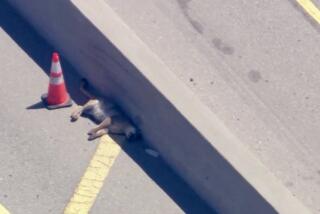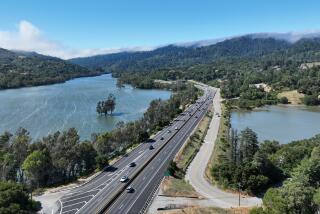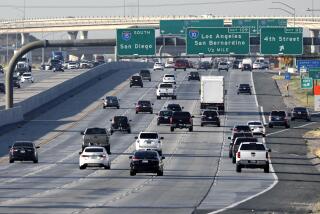Roundabouts Lead to Road Safety, New Study Finds
- Share via
WASHINGTON — Roundabouts, becoming more common in America’s road system, reduce deadly automobile accidents at intersections by nearly 90%, researchers said Friday.
Richard A. Retting, of the Insurance Institute for Highway Safety, said drivers have to get over their skepticism of the modernized traffic circles.
“Mistakes at roundabouts result in fender-benders. Mistakes at stop signs and traffic signals can be catastrophic,” said Retting, an author of the study. “Thousands of needless injuries could be prevented.”
The study involved 24 intersections that were converted to roundabouts. In roundabouts, drivers merge on a one-way road built around a landscaped circle. Roundabouts, unlike older circular intersections, don’t have traffic lights.
There were 38% fewer accidents at the roundabouts studied, the report found. Wrecks with injuries fell by 76% and accidents that caused deaths and very serious injuries dropped 89%.
About 300 roundabouts have been built in America over the past 10 years. “It’s slowly catching on,” said Mike Niederhauser, a transportation engineer for the state of Maryland. He said drivers initially complained that while roundabouts were popular in Europe, they wouldn’t necessarily work in America.
When city leaders in University Place, Wash., proposed a roundabout, resident Laurie Annah was skeptical. But she came around.
“It doesn’t seem to be the hassle and nuisance I thought it would be,” Annah said. “It just slows you down. I can see how it works.”
Retting and researchers from the University of Maine and Ryerson Polytechnic University in Toronto studied single and multilane roundabouts in California, Colorado, Florida, Kansas, Maine, Maryland, South Carolina and Vermont. Four of the intersections previously had traffic signals; 20 had stop signs.
Researchers found that motorists approach traditional intersections at about 30 mph, compared to about half that at roundabouts.
The study said that there are about 700,000 accidents with injuries, causing $1.3 million in damage, at intersections with traffic lights and stop signs in America each year. About half of all car crashes with injuries occur at intersections, researchers said.
“Widespread construction of roundabouts can produce substantial reductions in injuries and property damages,” researchers wrote in the study, published in the April issue of the American Journal of Public Health.
The design eliminates left turns, a major source of accidents, and rear-end collisions caused by drivers stopping suddenly at yellow lights. Also eliminated are accidents caused when a driver makes a right turn into the path of fast-moving traffic.
“This country has relied on traffic signals and signs since the advent of the automobile,” Retting said. “If you have an intersection you put up a stop sign, and if it’s too busy for that you put in a traffic signal, and if it’s too busy for a traffic signal you put in an overpass.”
Retting said traffic signals cost about $150,000 at major intersections, while roundabouts cost between $50,000 and $400,000. Roundabouts are not recommended for business districts or extremely busy intersections.
Darrin Shoemaker, who oversees transportation in Hilton Head Island, S.C., said roundabouts there have reduced complaints, mainly from people who felt they had to wait too long at traffic signals.
Roundabouts also save money on maintenance and energy for traffic signals, Retting said.
Then there’s the beauty issue.
“Instead of a big ugly slab of asphalt and traffic lights, there’s landscaping, grassy areas and, in some cases, fountains and rock formations,” Retting said.






